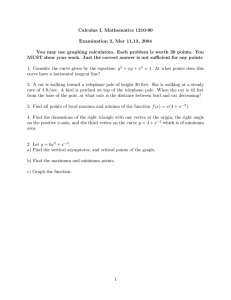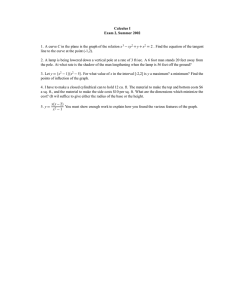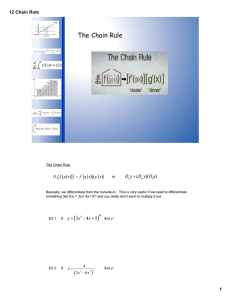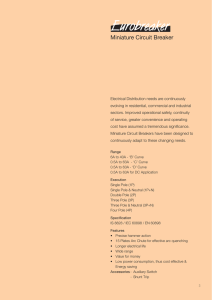Calculus I, Mathematics 1210-90 Examination 2, Mar 11,13, 2004: Answers
advertisement
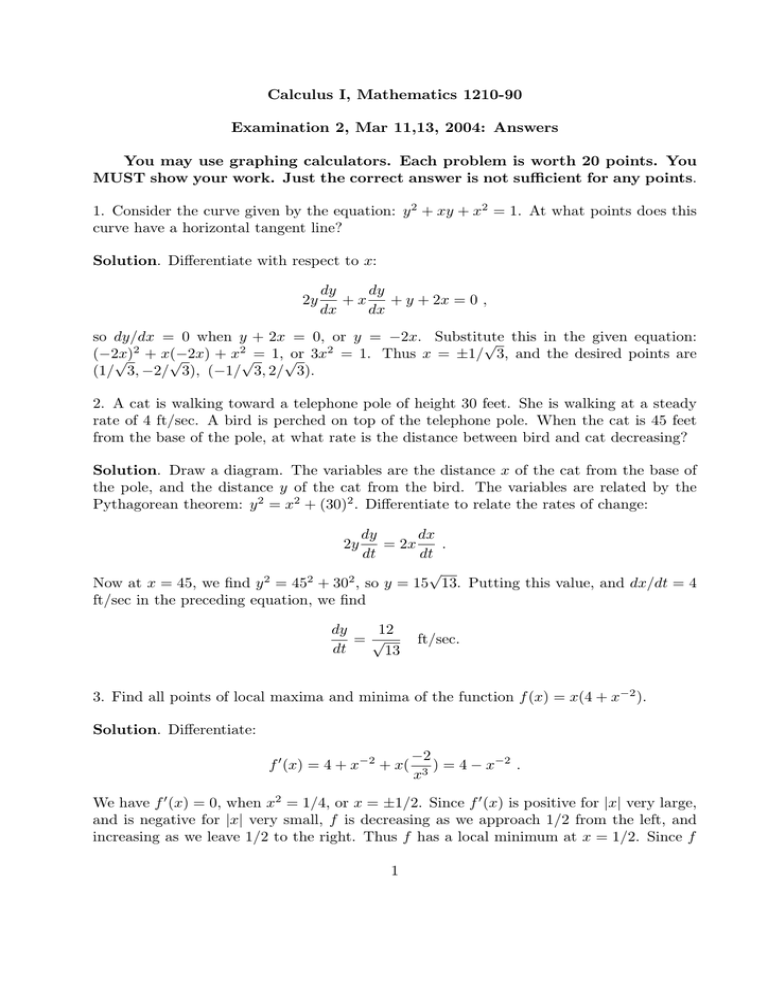
Calculus I, Mathematics 1210-90 Examination 2, Mar 11,13, 2004: Answers You may use graphing calculators. Each problem is worth 20 points. You MUST show your work. Just the correct answer is not sufficient for any points. 1. Consider the curve given by the equation: y 2 + xy + x2 = 1. At what points does this curve have a horizontal tangent line? Solution. Differentiate with respect to x: 2y dy dy +x + y + 2x = 0 , dx dx so dy/dx = 0 when y + 2x = 0, or y = −2x. Substitute √ this in the given equation: 2 2 2 (−2x) + x(−2x) + x = 1, or 3x = 1. Thus x = ±1/ 3, and the desired points are √ √ √ √ (1/ 3, −2/ 3), (−1/ 3, 2/ 3). 2. A cat is walking toward a telephone pole of height 30 feet. She is walking at a steady rate of 4 ft/sec. A bird is perched on top of the telephone pole. When the cat is 45 feet from the base of the pole, at what rate is the distance between bird and cat decreasing? Solution. Draw a diagram. The variables are the distance x of the cat from the base of the pole, and the distance y of the cat from the bird. The variables are related by the Pythagorean theorem: y 2 = x2 + (30)2 . Differentiate to relate the rates of change: dy dx = 2x . dt dt √ Now at x = 45, we find y 2 = 452 + 302 , so y = 15 13. Putting this value, and dx/dt = 4 ft/sec in the preceding equation, we find 2y dy 12 =√ dt 13 ft/sec. 3. Find all points of local maxima and minima of the function f (x) = x(4 + x−2 ). Solution. Differentiate: f 0 (x) = 4 + x−2 + x( −2 ) = 4 − x−2 . 3 x We have f 0 (x) = 0, when x2 = 1/4, or x = ±1/2. Since f 0 (x) is positive for |x| very large, and is negative for |x| very small, f is decreasing as we approach 1/2 from the left, and increasing as we leave 1/2 to the right. Thus f has a local minimum at x = 1/2. Since f 1 is an odd function, it has a local maximum at x = −1/2. Notice that f does not have a global maximum or minimum, since lim f (x) = −∞ , x→0− lim f (x) = ∞ . x→0+ 4. Find the dimensions of the right triangle with one vertex at the origin, the right angle on the positive x-axis, and the third vertex on the curve y = x + x−2 which is of minimum area. Solution. First, draw the diagram. The variables are: area A, the length of the base x, and the height y of the triangle. The variables are related by A= 1 xy , 2 y = 4 + x−2 , so A = (1/2)x(4 + x−2 ) = 2x + (1/2)x−1 . Differentiating: 1 dA =2− 2 . dx 2x Setting this equal to zero, and checking that the sign of dA/dx changes from negative to positive as we pass x = 1/2, we find that the minimum occurs when x = 1/2, and y = 8, so the minimum area is A = 2. 5. Let y = 6x2 + x−2 . a) Find the vertical asymptotes, and critical points of the graph. Rewrite 1 6x4 + 1 = , x2 x2 from which we see directly that x = 0 is a vertical asymptote, at which y → +∞. To find the critical points, we differentiate: y 0 = 12x − 2x−3 , and set equal to zero to √ find the solutions x = ±6−1/4 . Putting this in the equation for the curve, we find y = 2 6, so the √ −1/4 critical points are (±6 , 2 6). y = 6x2 + b) Find the maximum and √ minimum points. First look at the region x > 0. The only −1/4 critical point is (6 , 2 6), and since y → +∞ as x → +∞ and x → 0, this is a minimum. Since the function is even, both critical points are minima. c) To graph the function we need only add that y 00 > 0 for all x, so the curve is always concave up. 2
